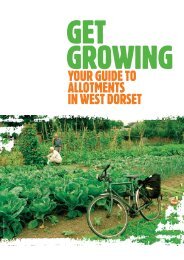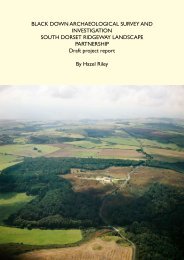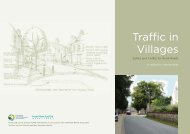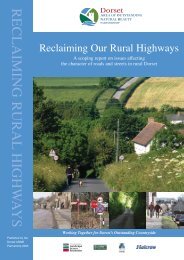Woodland Strategy 11.34 Mb - the Dorset AONB
Woodland Strategy 11.34 Mb - the Dorset AONB
Woodland Strategy 11.34 Mb - the Dorset AONB
You also want an ePaper? Increase the reach of your titles
YUMPU automatically turns print PDFs into web optimized ePapers that Google loves.
Section 3<br />
History<br />
The character of <strong>Dorset</strong>’s wooded landscapes has evolved through intricate interactions<br />
between nature and human activity. For centuries <strong>Dorset</strong>’s trees and woodlands have been<br />
subject to management and been an integral part of <strong>the</strong> local economy. This has left a<br />
valuable cultural and social legacy, which must be protected and managed to provide <strong>the</strong><br />
benefits expected from society now, and in <strong>the</strong> future.<br />
Eight thousand years ago as much as 80% of Great Britain was forest (albeit with wide open<br />
spaces grazed by large herbivores). By about two thousand years ago large-scale forest<br />
clearance for settlement and agriculture, combined with changes in <strong>the</strong> climate had already<br />
resulted in tree cover falling to around 20%, with distinct regional variations. This decline<br />
continued through most of <strong>the</strong> next two thousand years, and by 1900, forest and woodland<br />
cover was around 5%. People have shaped almost all of what we see today in <strong>the</strong> landscape,<br />
and many of <strong>the</strong> open spaces of <strong>the</strong> uplands and lowland heaths, as well as <strong>the</strong> layout of<br />
towns and villages, owe much to <strong>the</strong> actions of people many centuries ago.<br />
The Doomsday Book (published in 1086) quotes <strong>Dorset</strong> as having approximately 32,800<br />
hectares (81,000 acres) of woodland, including wood pasture (Rackham 1986), slightly higher<br />
than recent surveys of 28,758 hectares. In <strong>the</strong> Ancient <strong>Woodland</strong> Inventory, compiled and<br />
written by Jonathan Spencer, <strong>Dorset</strong> is quoted as having 7,749 hectares of ancient woodland.<br />
Melbury Park in North West <strong>Dorset</strong> is an outstanding example of well-treed parkland.<br />
Melbury Park was enclosed in 1547 and its continued management as a deer<br />
park with its individual trees of great antiquity explains why it is one of <strong>the</strong> richest<br />
localities for epiphytic lichens in Europe.<br />
<strong>Woodland</strong> archaeology can be categorised into those remnants from an earlier, open<br />
landscape preserved by tree cover, and those that relate to <strong>the</strong> past management of treecovered<br />
landscapes. From <strong>the</strong> former category, features and sites such as round barrows,<br />
burial mounds and prehistoric field systems exist in woodland. From <strong>the</strong> latter category,<br />
charcoal hearths, limekilns and brickworks inform us of past woodland management. All<br />
form part of <strong>the</strong> historic environment and provide <strong>the</strong> tools with which we can understand<br />
our past. They are a finite, non-renewable resource, and once lost, can not be replaced. To<br />
allow <strong>the</strong> interpretation and study of <strong>the</strong> historic environment by future generations, <strong>the</strong>y<br />
must be managed to ensure its preservation.<br />
Throughout <strong>the</strong> centuries woodlands of <strong>Dorset</strong> were extensively managed and provided<br />
economic and social functions to local communities. Until <strong>the</strong> 1800s, woodlands remained<br />
relatively intact. Over <strong>the</strong> last 200 years woodlands have become more linked to <strong>the</strong> cycle<br />
of modern economies and a great deal of timber was felled to meet <strong>the</strong> demands of two<br />
World Wars.<br />
<strong>Dorset</strong> has a history of plantations and natural regeneration of woodlands on heathlands<br />
and o<strong>the</strong>r formerly open space. In many areas removal of trees to re-create open ground of<br />
high nature conservation value has been very successful but in o<strong>the</strong>r areas mixed ‘wooded<br />
heath’ also provides suitable habitats for many species. Woods and forests that are managed<br />
successfully provide not only economic benefits but also social and environmental ones as<br />
well. The success of many species is a result of <strong>the</strong> combination of traditional management<br />
practices and commercial forestry providing suitable habitats for <strong>the</strong>se species and delivering<br />
priority Biodiversity Action Plans for endangered species.<br />
Motte & Bailey © Forestry Commission<br />
Since 1945, <strong>the</strong> direct loss of individual trees was largely driven by agricultural policies of <strong>the</strong><br />
time. Many veteran trees were felled to make way for new plantings as <strong>the</strong>y were thought<br />
to be of little value, or died due to unsympa<strong>the</strong>tic management practices such as hedgerow<br />
removal or over-shading. In more recent times veteran trees have suffered as <strong>the</strong>y are a<br />
“Health and Safety” hazard <strong>the</strong> misconception that <strong>the</strong>se trees are dead, dying or dangerous.<br />
Between 1946 and 1975, at least half of <strong>the</strong> ancient woodlands in <strong>Dorset</strong> had lost <strong>the</strong>ir<br />
ancient woodland characteristics through <strong>the</strong> planting of non-native species, reduction in<br />
appropriate management and lack of economic value (Rackham, 1990.) The remaining 50%<br />
maintain many ancient woodland characteristics but many suffer from inappropriate<br />
management.<br />
Commercial forestry consisting of non-native species was highly appropriate to <strong>the</strong> forestry<br />
policies and woodland objectives of <strong>the</strong> past. Many of <strong>the</strong>se forests have been managed very<br />
successfully and are now an important capital resource for <strong>the</strong>ir owners and have continued<br />
to be an important component of local timber industries. With <strong>the</strong> rise in <strong>the</strong> cost of<br />
15












